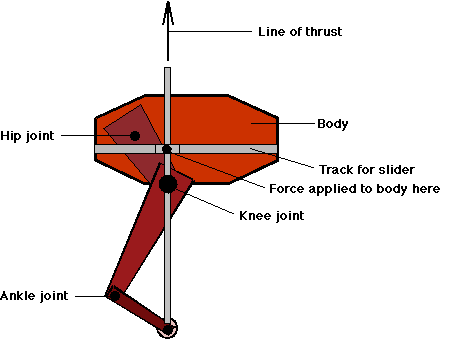
John Nagle
There are three joints because a leg with three joints can climb a slippery hill that a leg with two joints can't. This paper explains why this is so. This fact has implications for legged robots and animated legged creatures.
The reader is assumed to be familiar with Marc Raibert's work, in particular his book, "Legged Robots that Balance"[1] , as well as his paper with Jessica Hodgins on kangaroo locomotion.[2] Raibert controls articulated legs so they behave like the straight leg of the planar hopper. I have some improvements on that approach. This is an early note on some new work.
The anti-slip controller described in the author's previous paper[3] limits the torque applied to the balance actuator. It does this to limit the transverse forces between the foot and the ground, because that's what causes slipping. On slippery surfaces, this limit prevents large balance torques from being applied during the stance phase, which in turn limits the motions possible on slippery surfaces. This is OK, but limiting, especially during hill climbing, where the torque limits are rather low due to the hill angle.
With the straight-legged hopper, the thrust forces exerted by the hopping actuator are always aligned with the leg. With an articulated leg, there are more options. Raibert throws these options away, by always placing the knee so as to direct the thrust forces through a fixed point, usually the system center of gravity. That's not necessary, and there are real advantages to using those extra joints.
Because he assumes very high ground friction, Raibert doesn't have to worry about limiting balance torques. Once limited ground friction is accepted, you're forced to more realistic control approaches.

This is a kangaroo-type leg structure. The tail has been omitted, which is why it looks front-heavy. In this drawing, an articulated leg is linked to an equivalent mechanism like that of the planar hopper. You probably wouldn't actually build something like that, with both the articulated leg and the straight leg linkages tied together. It's a convenient way to help think about the motions involved.
There's an additional degree of freedom here. A second sliding joint is added to the hopper-like linkage, allowing forward/back motion of the point where the thrust is applied to the body. This provides an additional degree of freedom which maps directly to the moment applied to the body mass by the leg.
The next set of drawings shows how this works.



Here we see the leg in three different positions. The body and foot are in the same position for all three drawings, but the limbs have been moved to change the line of action of the thrust force. In the left drawing, the thrust force is being applied so as to produce a pitch-up rotation of the body. The middle drawing shows a neutral situation, where the thrust force is being applied through the center of gravity, thus imparting no rotational forces to the body. The right drawing shows the thrust force being applied to produce a pitch-down situation. Notice that with this structure, we can change the moment applied to the body without changing the foot position.
The result of this action is to apply rotational forces to the body, so it does roughly the same thing as the balance actuator does in the planar hopper. But it does it with smaller transverse forces at the foot/ground contact point. Thus, bigger balancing torques can be applied in this way than via the balance actuator alone. This allows more aggressive hill-climbing and operation on slippery surfaces.
The next step is to take away the hopper linkage, leaving only the articulated leg.



The three drawings illustrate the line of thrust being applied in front of, through, and behind, the center of gravity. But now this function is performed by servoing the rotational joints, rather than via a linkage. Detailed control strategies will be covered in a later paper.
The technology described in this paper is covered by a pending U.S. patent application.
Version 8, 27 OCT 1995
 Animats home page
Animats home page